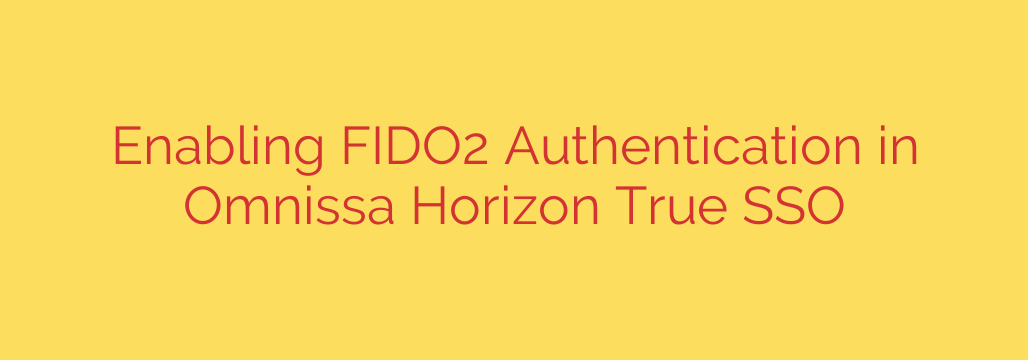
Boosting Security and Streamlining Access: Enabling FIDO2 Authentication in Horizon True SSO
Traditional password-based authentication presents ongoing security challenges, even within streamlined virtual desktop environments. While solutions like Horizon True SSO significantly enhance user experience by eliminating multiple logins, integrating stronger, phishing-resistant authentication methods is crucial. This is where FIDO2 security keys come in, offering a modern, highly secure alternative to traditional passwords and tokens.
Integrating FIDO2 with Horizon True SSO delivers significant advantages for organizations looking to elevate their security posture without compromising user productivity.
Why Combine FIDO2 with Horizon True SSO?
- Enhanced Security: FIDO2 keys offer robust protection against common threats like phishing, man-in-the-middle attacks, and credential stuffing. They leverage public-key cryptography, making them inherently more secure than relying solely on secrets like passwords.
- Streamlined Authentication Flow: Once a user successfully authenticates to their endpoint (like the Horizon Client) using their FIDO2 key, True SSO takes over to provide seamless access to their virtual desktop and published applications. This means users don’t face additional password prompts for internal resources secured by Active Directory Kerberos, preserving the single sign-on experience after the initial strong authentication.
- Path Towards Passwordless: FIDO2 enables phishing-resistant, multi-factor authentication and is a key technology for achieving passwordless login experiences, aligning with modern security best practices.
How FIDO2 Integration Works with True SSO (Conceptual Overview)
Implementing FIDO2 within the Horizon True SSO framework requires careful configuration across several infrastructure components. The process generally involves:
- Initial Authentication: The user authenticates to the Horizon environment using a FIDO2 security key (like a YubiKey) on their client device.
- Validation and Request: The Horizon infrastructure (specifically the Connection Server) validates this FIDO2 authentication. Upon successful validation, it initiates a request to issue a temporary Kerberos auto-enrollment certificate for the user.
- Certificate Issuance: An Enrollment Server, acting on behalf of the user and integrated with the organization’s Certificate Authority (CA) (typically Microsoft CA), issues a short-lived certificate based on the verified FIDO2 authentication.
- True SSO in Action: Horizon’s True SSO component uses this newly issued certificate to obtain a Kerberos Ticket-Granting Ticket (TGT) from the domain controllers. This TGT then allows the user to access their virtual desktop and internal Kerberos-secured applications seamlessly without being prompted for further credentials.
Key Components and Configuration Areas:
Successfully enabling this integration requires focus on:
- Horizon Connection Servers: Configuring them to accept and process FIDO2 credentials.
- Certificate Services Integration: Proper setup and configuration of your Microsoft Certificate Authority to work with the Enrollment Server and issue the necessary certificates based on FIDO2 authentication.
- Enrollment Servers: Deploying and configuring Enrollment Servers that can communicate with both the Horizon environment and the CA.
- Group Policies: Implementing and managing Group Policy Objects (GPOs) to control FIDO2 device registration and usage for users within the domain.
- Supported Hardware and Software: Ensuring compatibility between FIDO2 security keys, client operating systems, Horizon Client versions, and Horizon infrastructure components.
Actionable Implementation Tips:
Administrators planning this integration should:
- Verify Compatibility: Confirm that your current versions of Horizon components, Windows Server, Certificate Services, and client operating systems support FIDO2 integration with True SSO.
- Plan Your Certificate Infrastructure: Proper certificate template configuration on your CA is fundamental to True SSO functionality and must be set up correctly for FIDO2-based enrollment.
- Start with a Pilot: Implement and thoroughly test the FIDO2 + True SSO setup with a small group of users before rolling it out broadly.
- Educate Your Users: Provide clear instructions and training on how to register and use their FIDO2 security keys.
- Establish Device Management Processes: Plan for provisioning, loss, and replacement scenarios for FIDO2 security keys.
By carefully planning and implementing FIDO2 authentication alongside Horizon True SSO, organizations can achieve a powerful balance of robust security and effortless user access to their virtual desktop infrastructure. This represents a significant step forward in protecting sensitive data and improving the overall security posture of the environment.
Source: https://nolabnoparty.com/abilitare-lautenticazione-fido2-in-omnissa-horizon-true-sso/








